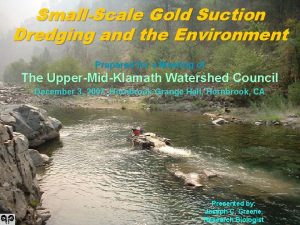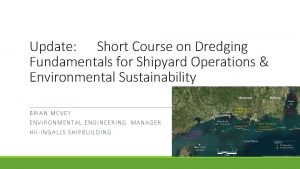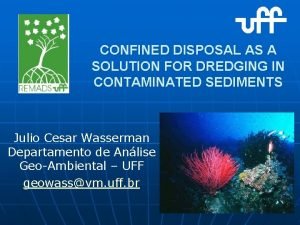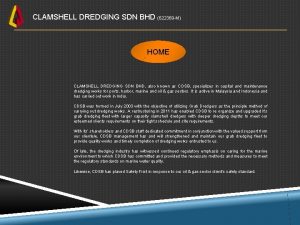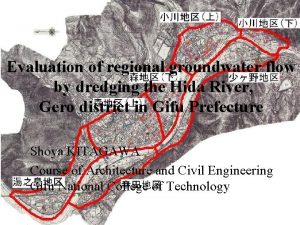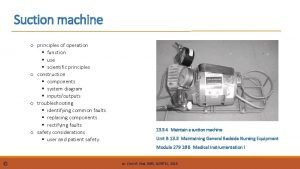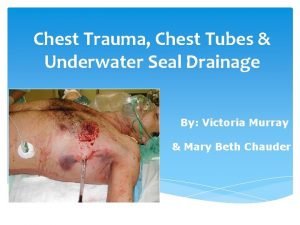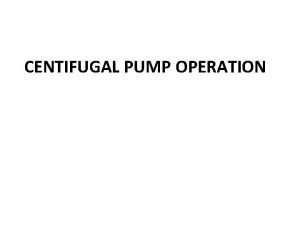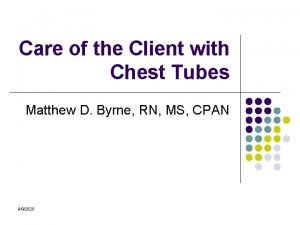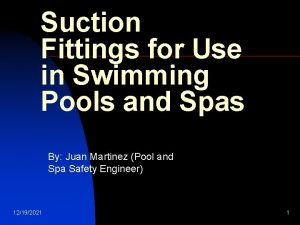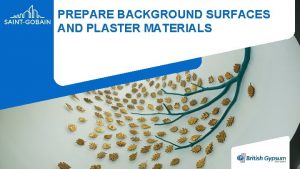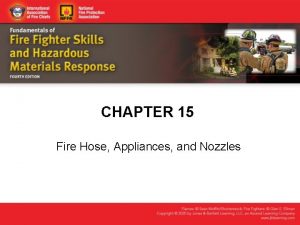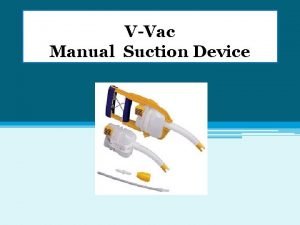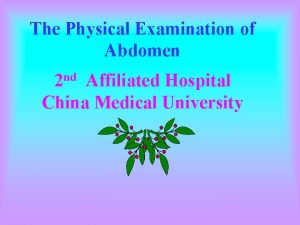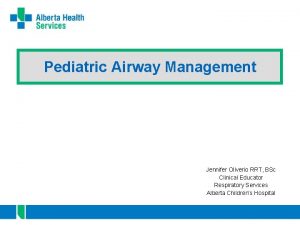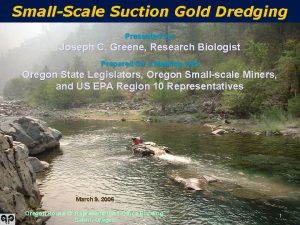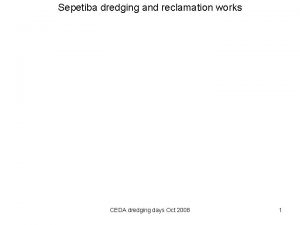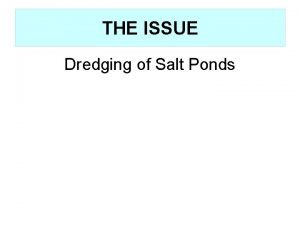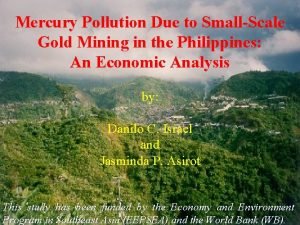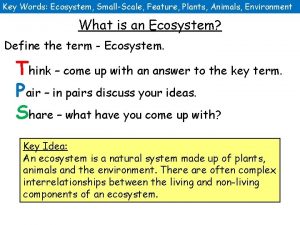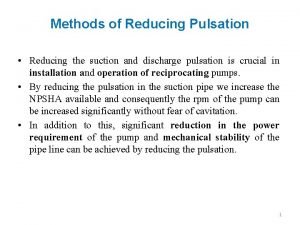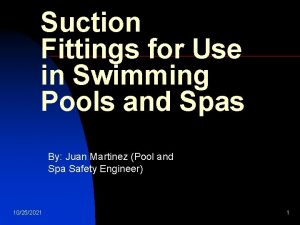SmallScale Gold Suction Dredging and the Environment Prepared










































































- Slides: 74

Small-Scale Gold Suction Dredging and the Environment Prepared for a Meeting of The Upper-Mid-Klamath Watershed Council December 3, 2007, Hornbrook Grange Hall, Hornbrook, CA Presented by: Joseph C. Greene, Research Biologist

It is my opinion that the results from scientific investigations, presented in the Environmental Impact Reports, prepared by the State of California, Clearwater National Forest and Siskiyou National Forest, provide all the evidence required to support the determination that small-scale suction dredging is de minimis and impacts from these dredges are less than significant.

The “Real” Problem Many people want outdoor settings to be left in a natural condition for quiet enjoyment. Thus suction dredging is perceived as a conflict with these activities. The noise of the suction dredge engines and exhaust fumes and the presence of the suction dredge activities may be the very things many people go outdoors to escape. However, suction dredgers also enjoy the outdoors. (CDFG, page V 25)

The “Real” Problem It should be noted that suction dredging is considered a legitimate activity on rivers and streams and suction dredge operators have a Federally mandated right to operate. Dredgers also have the basic right, of all citizens, to enjoy and utilize streams as long as their activities are in compliance with the laws and regulations of the State.

Research to Support the Siskiyou National Forest DEIR The SNF engaged Dr. Peter B. Bayley, Dept. Fisheries & Wildlife, Oregon State University, to conduct a “Cumulative Effects Analysis” on the effects of suction dredging forest-wide Dr. Bayley concluded: "The statistical analyses did not indicate that suction dredge mining has no effect on the three responses measured, but rather any effect that may exist could not be detected at the commonly used Type I error rate of 0. 05. " (In other words, if there are effects, they are so small they can't measure them. )

Dr. Bayley continued… "The reader is reminded of the effect of scale. Localized, short-term effects of suction dredge mining have been documented in a qualitative sense. However, on the scales occupied by fish populations such local disturbances would need a strong cumulative intensity of many operations to have a measurable effect. "

Dr. Bayley concluded… "Given that this analysis could not detect an effect averaged over good and bad miners and that a more powerful study would be very expensive, it would seem that public money would be better spent on encouraging compliance with current guidelines than on further study. "

For discussion the following excerpts were taken from the Draft Environmental Impact Report, Adoption of Amended Regulations for Suction Dredge Mining. 1997. State of California, Dept. of Fish and Game. The Conclusions in this report concur with those found in the Clearwater and Siskiyou National Forest Environmental Impact Reports. These documents are the culmination of literature searches for scientific evidence regarding the impacts of small-scale suction dredging on the environment and consultations with stakeholders and concerned citizens.

The area or length of river or streambed worked by a single suction dredger as compared to total river length is relatively small compared to the total available area. An individual suction dredge operation affects a relatively small portion of a stream or river. A small-scale suction dredge (representing 90 percent of all suction dredges) may spend a total of 4 to 8 hours per day in the water dredging an area from 1 to 10 m 2 (3 -33 ft 2). The average number of hours spent is 5. 6 hours per day. The remaining time is spent working on equipment and processing dredged materials.



Current regulations on most rivers and streams, in conjunction with riparian protective measures, results in a less than significant impact to channel morphology. Turbidity and sedimentation levels generally return to background levels within 20 to 80 m (66 -263 ft) below the dredging activities. In many of the studies performed on suction dredging, potentially adverse impacts to river resources were reported. However, the effects of increased turbidity levels and sedimentation, decreases in invertebrate populations and reconfiguration of the streambed were temporary and localized.

Suction dredging can have significant short-term and localized adverse impacts on local benthic invertebrate abundance and community composition. However, over the long-term, the impacts appear to be less than significant. Colonies of invertebrates generally re-colonize areas disturbed by suction dredges within a relatively short period of time ranging from one to two months. Impacts to benthic invertebrate communities, from suction dredging, appear to be less than significant.

Effects to benthic and/or invertebrate communities, turbidity and water quality appear to be less than significant. They are usually localized and temporary in duration!

Impacts on Fish Effects from elevated levels of turbidity and suspended sediment normally associated with suction dredging as regulated in the past in California appear to be less than significant with regard to impacts to fish and other river resources because of the level of turbidity created and the short distance downstream of a suction dredge where turbidity levels return to normal. ADULT FISH: Suction dredging appears to have little direct immediate physical effect on adult fishes in terms of harm from actual entrainment by dredges.

Impacts on Fish JUVENILE FISH: Entrained through a suction dredge did not appear to have a significant adverse effect on juvenile fish. YOLK SAC FRY: Entrainment can have a significant adverse effect on the more delicate stages of fish such as the yolk sac fry. During this stage the yolk sac can be easily ruptured or torn from the fish. FISH EGGS: Developing eggs of salmonids are significantly adversely affected by entrainment through suction dredges. The degree of harm may vary depending on species.

Impacts on Fish THE SOLUTION! Fish eggs and yolk sac fry are protected by regulations that keep small-scale suction dredgers out of the rivers and streams during the period of spawning and early life-stage growth. Current law requires that dredging operations must stop or move if redds are present during a permitted “In Water Work Period”.

Impacts on Spawning Gravel Most of the effects related to turbidity and sedimentation, and the disturbance of spawning gravels reported were temporary and localized, and therefore, represented impacts considered less than significant. Dredge piles do not appear to occupy a significant portion of the available spawning habitat so that dredge pile impacts are expected to be less than significant

Impacts on Spawning Gravel Once tailing piles are dispersed by high stream flows they do make up a component of the suitable spawning substrate. Approximately 60 salmonid redds were observed in a study on Canyon Creek, CA. None of the redds were found within dredge tailing piles. Stern, G. R. 1988. Effects of Suction Dredge Minin on Anadromous Salmonid Habitat in Canyon Creek, Trinity County, California. Masters Degree Thesis, Humbolt State University, 80 p.

Harvey and Lisle stated, “Effects of dredging commonly appear to be minor and local, but natural resource professionals should expect effects to vary widely among stream systems and reaches within systems. Fishery managers should be especially concerned when dredging coincides with the incubation of embryos in stream gravels or precedes spawning runs soon followed by high flows. ” HARVEY, B. C. and T. E. LISLE. 1998. Effects of Suction Dredging on Streams: a Review and an Evaluation Strategy. Fisheries, Vol. 23, No. 8

They continued, “Quantitative, uniform guidelines and regulations that are truly applicable and scientifically supportable for a variety of basins probably will never be found. Instead, basin-specific regulations will need to be created in a POLITICAL but scientifically informed process using information from a basin-scale analysis. ” HARVEY, B. C. and T. E. LISLE. 1998. Effects of Suction Dredging on Streams: a Review and an Evaluation Strategy. Fisheries, Vol. 23, No. 8

Harvey and Lisle “measured scour of the redds of Chinook salmon Oncorhynchus tshawytscha on dredge tailings and natural substrates in three tributaries of the Klamath River, California. ” They “measured maximum scour with scour chains and net scour by surveying before and after high winter flows. Scour of chinook salmon redds located on dredge tailings exceeded scour of redds on natural substrates, although the difference varied among streams. ” HARVEY, B. C. and T. E. LISLE. 1999. Scour of Chinook Salmon Redds on Suction Dredge Tailings. North American Journal of Fisheries Management 19: 613 -617

“The significance of dredge tailings to salmon populations may vary even among streams with similar patterns of scour. The proportion of Chinook salmon that spawn on dredge tailings would influence the population level effect of tailings and depend, in part, on the availability of spawning sites on natural substrates. If natural spawning sites were relatively abundant and tailings were not strongly selected, a small fraction of redds would be located on tailings. ” HARVEY, B. C. and T. E. LISLE. 1999. Scour of Chinook Salmon Redds on Suction Dredge Tailings. North American Journal of Fisheries Management 19: 613 -617

“In the lower 11 km (6. 8 mi) of the Scott River in 1995, only 12 of 372 (3. 2%) redds were located on tailings because much more natural substrate than dredge tailings provided spawning habitat and fish exhibited no strong preference for either substrate. ” J. Kilgore, U. S. Forest Service, unpublished data “However, where natural spawning substrate is in short supply, a large portion of redds may be located on dredge tailings. ” HARVEY, B. C. and T. E. LISLE. 1999. Scour of Chinook Salmon Redds on Suction Dredge Tailings. North American Journal of Fisheries Management 19: 613 -617

“In their study of Canyon Creek it was noted that chinook and coho salmon and steelhead (Oncorhynchus mykiss) spawned on actively dredged areas. Their maps of dredge sites and redd locations suggest that the following proportions of redds were on tailings: v 3 of 8 (37. 5%) spring chinook salmon redds in 1985; v 1 or 1 (100%) coho redd in 1985; and, v 1 of 11 (9. 1%) steelhead redds in 1985. ” “In the absence of information on the availability of spawning gravels, the degree of selection or avoidance of dredge tailings for spawning cannot be determined. ” Hassler, T. J. , W. L. Somer, and G. R. Stern. 1986. Impact of suction dredge mining on anadromous fish, invertebrates and habitat in Canyon Creek, California Cooperative Fishery Research Unit, Humbolt State University, Arcata, California.

“The significance of dredge tailings to salmon populations may vary even among streams with similar patterns of scour. The proportion of Chinook salmon that spawn on dredge tailings would influence the population level effect of tailings and depend, in part, on the availability of spawning sites on natural substrates. If natural spawning sites were relatively abundant and tailings were not strongly selected, a small fraction of redds would be located on tailings. ” “In the last 3 years (1996 -98), 72 of 1800 redds (4%) were counted on or near the tailings from suction dredge mining. ” Quihillalt, R. R. 1999. MAINSTEM TRINITY RIVER FALL CHINOOK SPAWNING REDD SURVEY, 1996 THROUGH 1998. U. S. Fish and Wildlife Service, Arcata, CA

“In 1996 1, 372 reds were observed on the mainstem Klamath River. Recreational suction dredge mining was present throughout the survey from the confluence of Scott River downstream to the confluence of Indian Creek, although only 2 redds (0. 15%) were observed on recent dredge tailings. ” U. S. Fish and Wildlife Service. 1997. Mainstem Klamath River Fall Chinook Spawning Redd Survey: Fiscal Year 1995 and 1996. USFWS, Coastal California Fish and Wildlife Office, Arcata, CA, 27 pp.

“…but evidence is emerging that stability of spawning gravel may be the critical limiting factor for salmon. In studies of aggraded stream beds in southwest Oregon, Nawa et al. (1990) found that scour and fill during minor storms (two year events) was sufficient to cause mortality of salmonid eggs and alevin. Nawa, R. K. , C. A. Frissell, and W. J. Liss. 1990. Life history and persistence of anadromous salmonid stocks in relation to stream habitats and watershed classification. Oak Creek Labs, Oregon State University. Corvalis, OR Performed under contract for Oregon Department of Fish and Wildlife. Work by Payne and Associates (1989) indicates that gravels are extremely unstable in lower Klamath tributaries and that mortality of eggs similar to that noted by Nawa et al. (1990) could be occurring there. Payne, T. R. and Associates. 1989. Lower Klamath River tributary delta study. US Department of Interior, Bureau of Indian Affairs, Redding, CA. Higgins, P. , S, Dobush and D, Fuller. 1992. FACTORS IN NORTHERN CALIFORNIA THREATENING STOCKS WITH EXTINCTION. Humboldt Chapter of the American Fisheries Society, Arcata, CA.

In his court declaration Dr. Peter Moyle stated, “It should be assumed there is harm, unless it can be proven otherwise, One reason for my taking this conservative position is that we simply do not know the effects of dredging on many species”. (page 8, lines 13 -15). Dr. Moyle goes on to say, “Even for salmonids, information on the effects of dredging, with the exception of a few studies such as that of Harvey (1989), is largely anecdotal or in non-peer reviewed reports”. (page 8, lines 20 -23). Declaration of Peter B. Moyle, Ph. d. , In Support of Entry of Stipulated Agreement, Karuk vs CA Dept. Fish and Game, Superior Court of California, County of Alameda, Hayward Division, Case No: RG 05 211597. Jan. 06, 2006.

ANECDOTAL In science, anecdotal evidence has been defined as: v "information that is not based on facts or careful study"; v "non-scientific observations or studies, which do not provide proof but may assist research efforts"; v "reports or observations of usually unscientific observers"; v "casual observations or indications rather than rigorous or scientific analysis“; and, v "information passed along by word-of-mouth but not documented scientifically“.

Researchers may use anecdotal evidence for suggesting new hypotheses, but never as supporting evidence.

Salmonids do not spawn in this type of coarse overburden “In steep mountain channels (with gradients >2%), natural spawning areas for salmonids are rare because the streambed is predominantly armored with cobbles and boulders too large to be moved by spawning fish during redd construction. ” Kondolf, G. M. , G. F. Cada, M. J. Sale, and T. Felando. 1991. Distribution and stability of potential salmonid spawning gravels in steep boulder-bed streams of the eastern Sierra Nevada. Transactions of the American Fisheries Society 120: 177 -186.

Turbidity It has been asserted that salmon were not affected by elevated turbidity but studies have stated that salmonid growth was reduced at 25 NTU but not below. Turbidity caused by suction dredging is highly variable. Suction dredging bedrock pockets containing only sand gravel causes virtually no change in turbidity whereas suction dredging clay deposits causes very noticeable turbidity.

Flood Stage, Klamath River above Portuguese Creek, 2006 “Mining debris is chemically inert, makes no oxygen demand on the stream and therefore takes away from the flowing water nothing which the fish require. This is equally true of this material whether placed in transit by nature or by man since the products are alike in nature and comes from the same sources…” Swartley, A. M. Appendix A. In: Ward, H. B. 1938. Placer Mining on the Rogue River, Oregon, in Its Relation to the Fish and Fishing in that Stream. Department of Geology and Mineral Industries, State of Oregon, Portland, OR

Klamath River water: The left vial was allowed to settled for 24 -hours, the right vial was shaken to re-suspend the particulates. The sample was measured at 656 NTU.

People with agendas often don’t put facts in perspective and blur the difference between facts and speculation!

Turbidity plumes, usually, do not cover wide areas of the stream and they are not continuous or consistent in sediment content

Turbidity Effects of the levels of turbidity and suspended sediment normally associated with suction dredging appear less than significant with regard to the health or physiology of adult and juvenile salmonids, particularly when one considers that turbidity levels return to normal levels on an average of 20 -80 m (66 -263 ft. ) below the suction dredge. Also, natural levels of turbidity may be higher than levels of turbidity caused by suction dredging during certain times of the year.

Notice the switch in plume turbidity density. Now the distant dredge plume is lower in suspend material concentration.

United States Department of Agriculture Forest Service Siskiyou National Forest, 200 NE Greenfield Road, Grants Pass, OR 97526 -0242 Reply to: 2800 Date: October 16, 1995 Subject: A comparison of stream materials moved by mining suction dredge operations to the natural sediment yield rates To: The Record …”There are 1, 092, 302 acres on the Siskiyou National Forest. Using a factor of 0. 33 cubic yards per acre per year times 1, 092, 302 acres will produce a very conservative estimate that 331, 000 cubic yards of material move each year from natural causes compared to the 2, 413 cubic yards that was moved by suction dredge mining operations in 1995 on the Siskiyou. This would be a movement rate by suction dredge mining that equals about 0. 7% of natural rates. ” MICHAEL F. COOLEY, Recreation, Lands and Minerals Staff Officer, Siskiyou National Forest

Constructing a nice deep hole for fish habitat while producing an almost imperceptible turbidity plume

Fish Feeding Fish have been observed feeding in turbid plumes created by suction dredging. Stern (1988) observed young steelhead feeding on dislodged invertebrates in turbid dredge plumes, even though clear water was available nearby. Cutthroat and rainbow trout have also been observed feeding. The effects of suction dredging on the feeding of fish appears to be less than significant. Although invertebrate populations are negatively affected by suction dredging, the impacts are localized and short-term. Stern, G. R. 1988. Effects of Suction Dredge Minin on Anadromous Salmonid Habitat in Canyon Creek, Trinity County, California. Masters Degree Thesis, Humbolt State University, 80 p.

Fish feeding below outfall from a small-scale suction gold dredge sluice box

Behavior and Distribution Studies in Canyon Creek, Butte Creek, and the North Fork American River, CA did not indicate a difference in fish distribution or density below or above suction dredging sites. Stern (1988) reported that suction dredging did not appear to influence the behavior of adult spring-run salmonids in their summer holding areas. Stern, G. R. 1988. Effects of Suction Dredge Minin on Anadromous Salmonid Habitat in Canyon Creek, Trinity County, California. Masters Degree Thesis, Humbolt State University, 80 p.

Behavior and Distribution Abandoned dredge holes can provide holding and resting areas for fish. Stern (1988) observed young steelhead in active and abandoned dredge holes in Canyon Creek. Suction dredge operators report adult salmon and steelhead moving into dredge holes overnight. Dredge holes often provide thermal and deeper water habitat for fish and some dredge holes in the Scott River, CA have held more juvenile salmonids than adjacent habitats. Stern, G. R. 1988. Effects of Suction Dredge Minin on Anadromous Salmonid Habitat in Canyon Creek, Trinity County, California. Masters Degree Thesis, Humbolt State University, 80 p.

Benefits to the Environment Small-scale suction dredge miners remove lead shot, fishing sinkers, bullets and other metals and fragments from streams and rivers. Removal of these materials by suction dredgers is considered a benefit to the environment.

Intention of Congress "The development of information which describes the relationship of pollutants to water quality is essential for carrying out the objective of the Clean Water Act. This information, known as criteria, is required under Section 304(a) to be developed and published by the Administrator and issued to the states and public. Criteria to be developed in this section should draw upon the best scientific knowledge on the subject, including information, if any, from the National Academy of Sciences, the U. S Geological Survey in the Department of Interior, scholarly literature, academic experts, and other sources. ”

Establishing Effects of Pollutants “Criteria establish the effects of pollutants on health or welfare, receiving water ecosystems and man, and identify the natural chemical, physical and biological integrity of the Nation's waters. ” “The concentration and dispersal of pollutants and their by products through biological, physical and chemical processes and any related changes in the diversity, productivity, or stability of receiving water ecosystems would be part of the information provided”.

Natural Integrity of Waters …may be determined: v Partially by consultation of historical records on species composition; v Partially from ecological studies of the area or comparable habitats; and, v Partially from modeling studies which make estimations of the balanced natural ecosystem based on available information.

USEPA Fact Sheet January 14, 2000 On Nov. 18, 1996, EPA and the two environmental groups entered into a settlement agreement to resolve a challenge to the general permit. The proposed permit sets conditions on the discharge - or release – of pollutants from the operation into waters of the United States. The settlement agreement required EPA to complete two studies related to the impact of placer mining on the natural environment in Alaska. One was to address the discharge of metals by placer mining operations and the other was to address the impact of suction dredge mining.

Impact of Suction Dredging on Water Quality, Benthic Habitat, and Biota in the Fortymile River, Resurrection Creek, and Chatanika River, Alaska FINAL REPORT Submitted June 1999 Prepared For: US Environmental Protection Agency Region 10 Seattle, Washington Prepared By: Aaron M. Prussian, Todd V. Royer, and G. Wayne Minshall Department of Biological Sciences Idaho State University Pocatello, Idaho

Alaska Study Summary The report described the results of research into the effects of commercial and small-scale suction dredging on the water quality, habitat, and biota of Fortymile River, Resurrection Creek and the Chatanika River, Alaska. Focus of the work on Fortymile River was on an 8 -inch suction dredge located on the main stem and a 10 -inch suction dredge located on the South Fork.

Alaska Study Summary Water chemistry measured on Fortymile River showed the primary effects of suction dredging were increased turbidity, total filterable solids, and Cu and Zn concentrations downstream of the dredge. The results from this sampling revealed a relatively intense, but localized, decline in water clarity during the time the dredge was operating. These variables returned to upstream levels within 80 -160 m (263 -524 ft. ) downstream of the dredge.

Alaska Study Summary Cross-sectional profiles indicate that the impact of the dredge piles relative to the width of the Fortymile River was small. Macroinvertebrate abundance and diversity were greatly reduced in the first 10 m (33 ft. ) below the dredge but returned to values seen at the reference site by 80 to 160 m (263 -524 ft. ) downstream of the dredge. One year after dredging on the main stem and South Fork of Fortymile River, recovery of macroinvertebrate diversity appeared to be substantial.

Alaska Study Summary The second component of this project was to examine the effects of small-scale suction dredging on smaller streams in Alaska. Sampling was conducted on Resurrection Creek and on the Chatanika River, Alaska. The results from Resurrection Creek showed that there was no difference in the macroinvertebrate communities between the mining area and the locations downstream of the mining area, in terms of macroinvertebrate density, taxa richness, EPT richness, or food resources.

Alaska Study Summary Results from the Chatanika River showed slight downstream decreases in macroinvertebrate density, but all other measures remained similar to those of the reference area. In general, the results are in agreement with other studies that have found only localized reductions in macroinvertebrate abundance in relation to small-scale suction dredging.

Result From the 40 -Mile River Study USEPA Fact Sheet January 14, 2000 The U. S. Environmental Protection Agency (EPA) Plans To Issue A Wastewater Discharge Permit To: Alaska Mechanical Placer Miners This will also serve as a notice of a FINDING OF NO SIGNIFICANT IMPACT

USEPA Fact Sheet January 14, 2000 The environmental groups believed that the suction dredge report (40 -mile River, Resurrection Creek, and Chatanika River) did not address all of the required elements as set out in the 1996 settlement agreement. To avoid further litigation over the general permits, EPA and the environmental groups entered into another settlement agreement.

While the U. S. Environmental Protection Agency chose to flex its legal muscle where scientific data does not justify their actions. Other Federal Agencies have stated the following: “. . . For decades, suction dredging has been essentially unmanaged. Its effects were considered insignificant and its consequences immeasurable. ” (Siskiyou National Forest Draft Environmental Impact Statement). “To regulate against a potential for harm, where none has been shown to exist, is unjustifiable and must be challenged. " And, the U. S. Army Corps of Engineers stated,


? Putting the Attack on Small-Scale Gold Suction Dredging into Perspective

Small-scale gold suction dredgers do not deliberately harm, capture, or kill fish. That is not their reason for working in America’s waterways! HOWEVER!

Some Contributions to Salmonid Declines ü Conservation problems can arise from in-river fisheries in the Klamath Basin if high fishing effort is exerted while stocks at risk are passing through the lower river. U. S. Fish and Wildlife Service. 1990. Klamath-Trinity River Basin spring chinook salmon stock evaluation and run size forecast. USFWS Fisheries Assistance Office, Arcata, CA. 31 pp. ü The whiting fishery off the California coast has been allowed an incidental catch of 10, 000 Klamath River chinook salmon. The effects on the ocean food web of removing millions of pounds of whiting and potential food resource depletion for adult chinook salmon has never been evaluated. Higgins, P. , S. Dobush and D. Fuller. 1992. Factors in Northern California Threatening Stocks with Extinction. Report, Humbolt Chapter of the American Fisheries Society, 26 pp. ü Decline of summer steelhead and spring chinook populations on the Salmon River and the South Fork of the Trinity River are at least partially as a result of poaching. Higgins, P. , S. Dobush and D. Fuller. 1992. Factors in Northern California Threatening Stocks with Extinction. Report, Humbolt Chapter of the American Fisheries Society, 26 pp.

Some Contributions to Salmonid Declines ü Trampling of redds during fishing and recreational activities has a potential to cause high mortality of salmonids. One study of angler wading caused high mortality (43%-96%) of alevins (very young salmon that remain in the gravel) with only one or two passes per day. The extent or cumulative effects of this type of disturbance are not known (Roberts and White 1992). Pacific States Marine Fisheries Commission. 1999. Appendix A, ESSENTIAL FISH HABITAT, DESCRIPTION OF ADVERSE EFFECTS ON PACIFIC SALMON ESSENTIAL FISH HABITAT. http: //www. pcouncil. org/salmon/salfmp/a 14/99 efh 3. pdf ü Studies in Alaska and New Zealand have found that in shallow water where boat use is high, and especially where channels are constricted, developing salmon eggs and alevins in the gravel can suffer high mortalities as a result of pressure changes caused by boat operations, which can result in removal of gravel or mechanical shock generated in the area under the mid-line of the boat. (Horton 1994, Sutherland Ogle 1975) Pacific States Marine Fisheries Commission. 1999. Appendix A, ESSENTIAL FISH HABITAT, DESCRIPTION OF ADVERSE EFFECTS ON PACIFIC SALMON ESSENTIAL FISH HABITAT. http: //www. pcouncil. org/salmon/salfmp/a 14/99 efh 3. pdf

Some Contributions to Salmonid Declines ü Through Oct. 28, three days before the end of the season, Oregon fishermen caught 34, 729 Chinook coast wide. Last year, 31, 892 Chinook were caught, but only in the area between Florence and the Washington border. Susan Chambers, Staff Writer. November 10, 2007. Trollers want disaster declared. Coos Bay World Link. http: //www. theworldlink. com/articles/2007/11/10/news/doc 4735523 e 8 b 26 e 475395366. txt ü “…the Yurok tribe caught their fish limit within a few weeks. The same went for the Hoopa, who caught their limits quickly. Together, the tribes have a 40, 800 commercial fish limit, but they split it between themselves. ” Phil Hayworth. November 14, 2007. Salmon: slow start, strong finish. Pioneer Press, Page E 7, Fort Jones, CA.

Some Contributions to Salmonid Declines The American Fisheries Society Reported (1992) all the factors that have caused serious harm to the salmonids. Fires, Floods, and Logging are among the major issues. So is the destruction of native runs by bringing in out of basin fish to supplement hatchery runs. Small-scale suction dredging is not listed among the problems. Higgins, P. , S, Dobush and D, Fuller. 1992. FACTORS IN NORTHERN CALIFORNIA THREATENING STOCKS WITH EXTINCTION. Humboldt Chapter of the American Fisheries Society, Arcata, CA.

Some Natural Contributions to Declines "Extensive wild land fires burned large areas of Californiain 1987, causing destabilization of many watersheds. Numerous middle Klamath River tributaries were affected including important anadromous fish producing streams such as Grider Creek, Elk Creek, Indian Creek and Clear Creek. Salvage logging after the burns may have significantly elevated erosion and mass wasting potential. Higgins, P. , S, Dobush and D, Fuller. 1992. FACTORS IN NORTHERN CALIFORNIA THREATENING STOCKS WITH EXTINCTION. Humboldt Chapter of the American Fisheries Society, Arcata, CA.

Some Natural Contributions to Declines Records of northern California precipitation from 1988 to 1992 show very low rainfall from October through December. These months are the critical spawning time for chinook and coho salmon runs. The drought has restricted access to many tributary spawning salmon stocks for almost a full life cycle. Downey, Scott: California Fish and Game Restoration Coordinator, Eel and Mattole Rivers. ; Morford, Mike: Member of Klamath River Management Council Technical Team. These fish have been forced to spawn in main river habitat where the risk of mortality of eggs and alevins is very high, because of stream bed movement and poor gravel quality. Higgins, P. , S, Dobush and D, Fuller. 1992. FACTORS IN NORTHERN CALIFORNIA THREATENING STOCKS WITH EXTINCTION. Humboldt Chapter of the American Fisheries Society, Arcata, CA.

Some Natural Contributions to Declines Success of main river spawners seems to have greatly decreased after the 1955 or 1964 floods (Scott Downey and Mike Morford personal communication). Downey, Scott: California Fish and Game Restoration Coordinator, Eel and Mattole Rivers. ; Morford, Mike: Member of Klamath River Management Council Technical Team. Main river channels have become increasingly unsuitable for all salmonids during summer months due to high stream temperatures (Kubicek 1977, Rogers and Wood 1991, USFWS 1991). Kubicek, P. F. 1977. Summer water temperature conditions in the Eel River system with reference to trout and salmon. M. S. Thesis, Humboldt State University, Arcata, CA. 198 p. ; Rogers, D. and R. Wood. 1991. Shasta River Fisheries Water Quality Project, 1990 -91. Funded by Klamath River Task Force, US Fish and Wildlife Service. Klamath Field Office, Yreka, CA. 39 pp. ; U. S. Fish and Wildlife Service. 1991. Long Range Plan for the Klamath River Basin Conservation Area Fishery Restoration Program. Klamath Field Office, Yreka, CA. 320 pp. Higgins, P. , S, Dobush and D, Fuller. 1992. FACTORS IN NORTHERN CALIFORNIA THREATENING STOCKS WITH EXTINCTION. Humboldt Chapter of the American Fisheries Society, Arcata, CA.

Some CDFG Contributions to Declines Studies have shown that anadromous salmonids transferred to other watersheds rarely persist for more than two generations without assistance from artificial culture, due to lack of appropriate adaptations to their new environment. Altukhov, Y. P. and EA. Salmenova 1986. Stock transfer relative to natural organization, management, and conservation of fish populations. In: N. Ryman and F. Utter (eds. ) Population Genetics and Fisheries Management University of Washington Press. Seattle, WA. Withler (1982), in an extensive literature review, found no successful case anywhere on the West Coast of establishing a new run of anadromous salmonids by transplanting stocks. Withler, F. C. 1982. Transplanting Pacific Salmon. Canadian Technical Reporto f Fisheries and Aquatic Sciences 1079. 27 p. 24. Higgins, P. , S, Dobush and D, Fuller. 1992. FACTORS IN NORTHERN CALIFORNIA THREATENING STOCKS WITH EXTINCTION. Humboldt Chapter of the American Fisheries Society, Arcata, CA.

Some CDFG Contributions to Declines Non-native anadromous salmonids have been transferred routinely by the California Department of Fish and Game to almost all north coast basins. The Iron Gate Hatchery coho broodstock was founded with eggs from the Columbia River Basin and has since been transplanted to several Klamath River tributaries, Prairie Creek Hatchery, Mad River Hatchery, Smith River, Freshwater Creek and other locations (Marshall 1970, Hiser 1978 -89). Marshall, L. 1970. Annual Iron Gate Salmon and Steelhead Hatchery Report, Fifth Year of Operation, 1969 -70. CDFG Inland Fisheries Division, Region 1, Redding, Sacramento, CA. ; Hiser, C. A. 1978 -89. Annual Report from Iron Gate Salmon and Steelhead Hatchery. California Department of Fish and Game. Inland Fisheries Div. Sacramento, CA. Trinity River Hatchery’s coho salmon broodstock was formed from numerous non- native. stocks, and subsequently planted in the South Fork of the Trinity River and Mad River Hatchery (Beddell, 1974 -1989). Bedell, G. W. 1974 -89. Annual Report for Trinity River Salmon and Steelhead Hatchery. California Dept. of Fish and Game. Inland Fisheries Div. Sacramento, CA. Higgins, P. , S, Dobush and D, Fuller. 1992. FACTORS IN NORTHERN CALIFORNIA THREATENING STOCKS WITH EXTINCTION. Humboldt Chapter of the American Fisheries Society, Arcata, CA.

Some CDFG Contributions to Declines Coho salmon stocks from the Quilcene (Washington) and Klaskanine Rivers (Oregon) were widely transplanted throughout northwestern California in the 1950’s and 1960’s (Richard Ridenhour, personal communication). Ridenhour, Richard: Professor of Fisheries, Humboldt State University, Arcata. The impacts of stock transfers increase dramatically if non-native anadromous salmonids are planted on top of wild populations for several generations (Riggs, 1990). If this occurs, “genetic swamping” or loss of local adaptations may lead to population extinction. Riggs, L. 1990. Principles for genetic conservation and production quality. Northwest Power Planning Council contract no. C 90 - 005. Portland, OR Higgins, P. , S, Dobush and D, Fuller. 1992. FACTORS IN NORTHERN CALIFORNIA THREATENING STOCKS WITH EXTINCTION. Humboldt Chapter of the American Fisheries Society, Arcata, CA.

"Despite extensive and prolonged habitat depletion and degradation, northern California continues to possess significant quantities of productive salmonid habitat. Disturbingly, much of this habitat receives little utilization due to depressed natural spawner escapements. " Higgins, P. , S, Dobush and D, Fuller. 1992. FACTORS IN NORTHERN CALIFORNIA THREATENING STOCKS WITH EXTINCTION. Humboldt Chapter of the American Fisheries Society, Arcata, CA.

Opponents of small-scale gold suction dredge mining attempt to isolate the activity and target it as operations that are perpetuating evil and serious harm against nature. Science does not support this radical position. All evidence has demonstrated that the effect of small scale suction dredging is LESS-THAN-SIGNIFICANT!
 Caught suction dredging in california
Caught suction dredging in california Pro minent
Pro minent Western dredging association
Western dredging association Suspended particulate matter
Suspended particulate matter Clamshell dredging
Clamshell dredging Dredging
Dredging Dredging
Dredging The business of making and serving prepared food and drink.
The business of making and serving prepared food and drink. Financial environment of business
Financial environment of business Suction machine parts and function
Suction machine parts and function R22 high and low pressure chart
R22 high and low pressure chart Why is carcase meat prepared into cuts joints and mince
Why is carcase meat prepared into cuts joints and mince A carefully prepared and rehearsed speech
A carefully prepared and rehearsed speech Sharon milgram nih
Sharon milgram nih Types of suctioning
Types of suctioning Slurry pump suction piping
Slurry pump suction piping High suction backgrounds plastering
High suction backgrounds plastering Parts of a chest tube
Parts of a chest tube Moisture control dental
Moisture control dental Centifugal pump
Centifugal pump Tidaling
Tidaling Bilge and ballast system
Bilge and ballast system Pool suction fittings
Pool suction fittings Prepare background
Prepare background Nebuliser training
Nebuliser training At the end of suction stroke in vertical ic er
At the end of suction stroke in vertical ic er Rusty heat exchanger
Rusty heat exchanger Back suction mixture control
Back suction mixture control Soft sleeve hose
Soft sleeve hose Laderal move
Laderal move Suction machine cleaning checklist
Suction machine cleaning checklist Constavac suction
Constavac suction Succussion splash cow
Succussion splash cow Jenna oliverio glow up
Jenna oliverio glow up Hát kết hợp bộ gõ cơ thể
Hát kết hợp bộ gõ cơ thể Frameset trong html5
Frameset trong html5 Bổ thể
Bổ thể Tỉ lệ cơ thể trẻ em
Tỉ lệ cơ thể trẻ em Voi kéo gỗ như thế nào
Voi kéo gỗ như thế nào Chụp phim tư thế worms-breton
Chụp phim tư thế worms-breton Hát lên người ơi alleluia
Hát lên người ơi alleluia Môn thể thao bắt đầu bằng từ chạy
Môn thể thao bắt đầu bằng từ chạy Thế nào là hệ số cao nhất
Thế nào là hệ số cao nhất Các châu lục và đại dương trên thế giới
Các châu lục và đại dương trên thế giới Cong thức tính động năng
Cong thức tính động năng Trời xanh đây là của chúng ta thể thơ
Trời xanh đây là của chúng ta thể thơ Mật thư tọa độ 5x5
Mật thư tọa độ 5x5 Phép trừ bù
Phép trừ bù độ dài liên kết
độ dài liên kết Các châu lục và đại dương trên thế giới
Các châu lục và đại dương trên thế giới Thể thơ truyền thống
Thể thơ truyền thống Quá trình desamine hóa có thể tạo ra
Quá trình desamine hóa có thể tạo ra Một số thể thơ truyền thống
Một số thể thơ truyền thống Cái miệng nó xinh thế
Cái miệng nó xinh thế Vẽ hình chiếu vuông góc của vật thể sau
Vẽ hình chiếu vuông góc của vật thể sau Thế nào là sự mỏi cơ
Thế nào là sự mỏi cơ đặc điểm cơ thể của người tối cổ
đặc điểm cơ thể của người tối cổ Ví dụ về giọng cùng tên
Ví dụ về giọng cùng tên Vẽ hình chiếu đứng bằng cạnh của vật thể
Vẽ hình chiếu đứng bằng cạnh của vật thể Tia chieu sa te
Tia chieu sa te Thẻ vin
Thẻ vin đại từ thay thế
đại từ thay thế điện thế nghỉ
điện thế nghỉ Tư thế ngồi viết
Tư thế ngồi viết Diễn thế sinh thái là
Diễn thế sinh thái là Dạng đột biến một nhiễm là
Dạng đột biến một nhiễm là Số nguyên là gì
Số nguyên là gì Tư thế ngồi viết
Tư thế ngồi viết Lời thề hippocrates
Lời thề hippocrates Thiếu nhi thế giới liên hoan
Thiếu nhi thế giới liên hoan ưu thế lai là gì
ưu thế lai là gì Khi nào hổ mẹ dạy hổ con săn mồi
Khi nào hổ mẹ dạy hổ con săn mồi Khi nào hổ con có thể sống độc lập
Khi nào hổ con có thể sống độc lập Sơ đồ cơ thể người
Sơ đồ cơ thể người Từ ngữ thể hiện lòng nhân hậu
Từ ngữ thể hiện lòng nhân hậu
